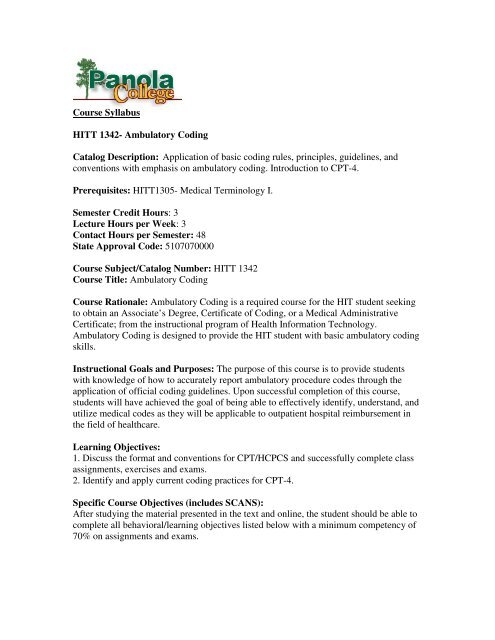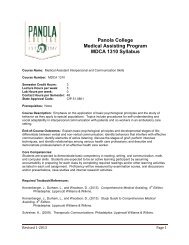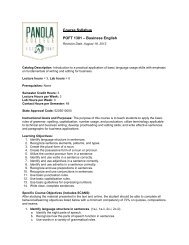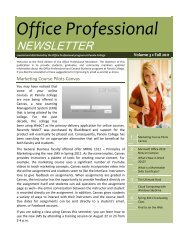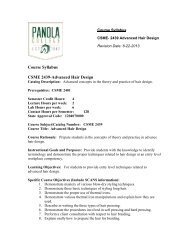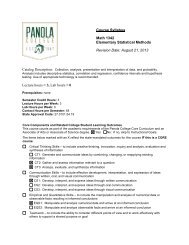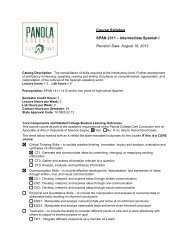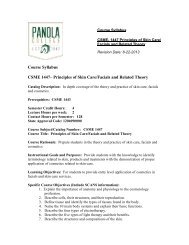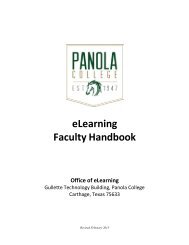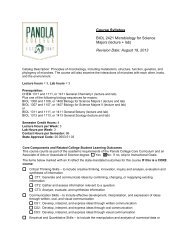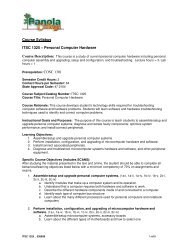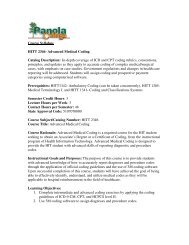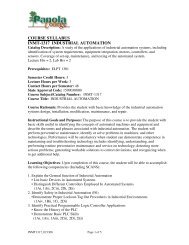Course Syllabus HITT 1342- Ambulatory Coding ... - Panola College
Course Syllabus HITT 1342- Ambulatory Coding ... - Panola College
Course Syllabus HITT 1342- Ambulatory Coding ... - Panola College
You also want an ePaper? Increase the reach of your titles
YUMPU automatically turns print PDFs into web optimized ePapers that Google loves.
<strong>Course</strong> <strong>Syllabus</strong><br />
<strong>HITT</strong> <strong>1342</strong>- <strong>Ambulatory</strong> <strong>Coding</strong><br />
Catalog Description: Application of basic coding rules, principles, guidelines, and<br />
conventions with emphasis on ambulatory coding. Introduction to CPT-4.<br />
Prerequisites: <strong>HITT</strong>1305- Medical Terminology I.<br />
Semester Credit Hours: 3<br />
Lecture Hours per Week: 3<br />
Contact Hours per Semester: 48<br />
State Approval Code: 5107070000<br />
<strong>Course</strong> Subject/Catalog Number: <strong>HITT</strong> <strong>1342</strong><br />
<strong>Course</strong> Title: <strong>Ambulatory</strong> <strong>Coding</strong><br />
<strong>Course</strong> Rationale: <strong>Ambulatory</strong> <strong>Coding</strong> is a required course for the HIT student seeking<br />
to obtain an Associate’s Degree, Certificate of <strong>Coding</strong>, or a Medical Administrative<br />
Certificate; from the instructional program of Health Information Technology.<br />
<strong>Ambulatory</strong> <strong>Coding</strong> is designed to provide the HIT student with basic ambulatory coding<br />
skills.<br />
Instructional Goals and Purposes: The purpose of this course is to provide students<br />
with knowledge of how to accurately report ambulatory procedure codes through the<br />
application of official coding guidelines. Upon successful completion of this course,<br />
students will have achieved the goal of being able to effectively identify, understand, and<br />
utilize medical codes as they will be applicable to outpatient hospital reimbursement in<br />
the field of healthcare.<br />
Learning Objectives:<br />
1. Discuss the format and conventions for CPT/HCPCS and successfully complete class<br />
assignments, exercises and exams.<br />
2. Identify and apply current coding practices for CPT-4.<br />
Specific <strong>Course</strong> Objectives (includes SCANS):<br />
After studying the material presented in the text and online, the student should be able to<br />
complete all behavioral/learning objectives listed below with a minimum competency of<br />
70% on assignments and exams.
1. Discuss the format and conventions for CPT/HCPCS and successfully<br />
complete class assignments, exercises and exams. (SCANS 1a-iv. 1a-v. 1bi. 1bii.<br />
1b-iii. 1b-iv. 1b-v. 1c-i. 1c-ii. 1c-iii. 1c-iv. 1c-v. 2a-i. 2a-iii. 2b-i. 2b-ii. 2b-iv.<br />
2b-vi. 2c-i. 2c-ii. 2c-iii. 2c-iv.)<br />
a. Discuss CPT coding rules and the basic CPT coding guidelines<br />
b. Distinguish between CPT Codes and National Codes<br />
c. Identify the purpose and uses of CPT<br />
d. Identify the official publication for CPT coding<br />
e. Differentiate between CPT and ICD-9-CM<br />
f. Identify the contents of CPT: sections, subsections, subcategory, etc.<br />
g. Differentiate between Category I, Category II, and Category III CPT<br />
codes<br />
h. Discuss the purpose of modifiers and state the uses of modifiers for<br />
surgical procedures<br />
2. Identify and apply current coding practices for CPT-4. (SCANS 1a-iv. 1a-v.<br />
1bi. 1b-ii. 1b-iii. 1b-iv. 1b-v. 1c-i. 1c-ii. 1c-iii. 1c-iv. 1c-v. 2a-i. 2a-iii. 2b-i. 2b-ii.<br />
2b-iv. 2b-vi. 2c-i. 2c-ii. 2c-iii. 2c-iv.)<br />
a. Demonstrate ability to identify and apply basic CPT coding steps by correctly<br />
abstracting pertinent clinical information from operative reports.<br />
b. Demonstrate ability to identify and apply basic CPT coding guidelines by<br />
correctly referencing official coding guidelines to support accurate code<br />
assignment.<br />
c. Demonstrate ability to identify and apply basic CPT coding steps by<br />
appropriately appending a CPT code with the correct modifier, as applicable.<br />
d. Demonstrate ability to code specific types of ambulatory services, which<br />
include the following:<br />
i. Surgery<br />
1. List components of a surgical package<br />
2. Distinguish between the CPT definition of surgical<br />
package and Medicare definition<br />
3. Define National Correct <strong>Coding</strong> Initiative<br />
4. Identify guidelines for coding surgical procedures<br />
5. Differentiate between simple, intermediate and complex<br />
wound repairs<br />
6. Differentiate between surgical and diagnostic<br />
endoscopies<br />
ii. Radiology, Pathology and Laboratory, Medicine, Anesthesia<br />
1. Assign modifiers associated with radiological<br />
procedures<br />
2. Discuss the appropriate use of organ- or diseaseoriented<br />
panels<br />
3. Discuss guidelines to identify injections and infusions<br />
4. Discuss the need for “qualifying circumstances” and<br />
“physical status” codes and apply the codes to<br />
anesthesiology records.
5. Identify that a procedure/service has been successfully<br />
assigned CPT codes for all of the above listed<br />
ambulatory services.<br />
iii. HCPCS Level II<br />
1. Identify the structure of HCPCS Level II codes<br />
2. Discuss the general guidelines for HCPCS Level II<br />
coding assignment<br />
iv. Evaluation and Management Services<br />
1. Differentiate between a new and established patient<br />
2. Identify the components listed included in the<br />
descriptors for the levels of E/M services<br />
3. Assign appropriate E/M code, when provided with a<br />
case scenario<br />
<strong>Course</strong> Content:<br />
Students in all sections of <strong>Ambulatory</strong> <strong>Coding</strong> will be required to do the following:<br />
1. Students will demonstrate knowledge of course material by completing course<br />
examinations given over lecture and textbook material.<br />
2. Students will complete all daily assignments as instructed.<br />
Methods of Instruction/<strong>Course</strong> Format/Delivery:<br />
Students will meet regularly for lecture over the material. The student is expected to<br />
attend all face-to-face class meetings of those in which the student is enrolled. The<br />
resources provided, for this class, through WebCT include:<br />
* A calendar displaying assignments each week (assignments will also be given in class)<br />
* Email (totally contained within WebCT)<br />
* Extra credit opportunities<br />
Assignments will not be accepted via WebCT. The assignments are only listed on the<br />
calendar as a reminder. However, after the assignment has been graded by the instructor,<br />
the student will be able to view his or her grades by clicking the My Grades link in the<br />
left banner.<br />
Students should use the Email within WebCT to communicate with the instructor. Using<br />
WebCT email gives you access to the instructor and other classmates without having to<br />
remember or type email addresses- you must select a name from the list. If you are not<br />
able to contact me using email in WebCT, you may use my <strong>Panola</strong> <strong>College</strong> email<br />
address, contact me by telephone, or stop by my office. I attempt to respond to all email<br />
within 24 hours. Please always include a subject line and your name in your email.<br />
Attendance Policy: This class will meet twice each week, on Tuesday and Thursday at<br />
8:00am for a period of 75 minutes each session. Attendance will be checked and recorded<br />
in the instructor’s grade book at each class meeting. A maximum of three days of absence<br />
will be allowed. If a student is absent more than three days, they may be dropped from<br />
the class (see <strong>Panola</strong> <strong>College</strong> Catalog). In the event the student is not dropped from the
class roster due to excessive absenteeism, the instructor may give the student a lettergrade<br />
decrease for every day absent.<br />
Students are responsible for all assignments, even in the event of an absence. Late tests<br />
and assignments may result in a lowered grade.<br />
Students are encouraged to please be on time for all class sessions. Late arrivals result in<br />
class disruptions. If students arrive late (less than a quarter hour, 15 minutes) they will be<br />
recorded as tardy. Three times of tardy will equal one absence. Additionally, leaving<br />
class early without the instructor’s permission will be recorded as one absence.<br />
Note: Withdrawing from this course is the student’s responsibility. Students who<br />
fail to officially withdraw by notifying the Records and Admission Office will<br />
receive the grade of “F” in the class. Refer to the <strong>College</strong> Calendar for the<br />
official Last Day to Withdraw.<br />
Make-Up Exams: Make-up exams will be allowed if the student has an approved<br />
absence. Exams must be made up within 1 week of the missed exam. The exam may<br />
differ in format from the original exam. Time provided to take make-up exams will not<br />
exceed the time allowed for test during a regular class session (i.e. if the class session is<br />
75 minutes, the student will have 75 minutes to take the make-up exam).<br />
Academic Integrity: Academic misconduct will not be tolerated. Any incident of<br />
academic misconduct will result in a failing grade for the test or assignment.<br />
Classroom Etiquette: All cell phones should be turned off prior to entering the<br />
classroom. Additionally, students are expected to display tolerance for other’s views<br />
during classroom discussions. Comments and language used should be appropriate for a<br />
professional setting.<br />
Assessment:<br />
The following items will be assigned during the semester and used to calculate the<br />
student’s final grade:<br />
* Daily Assignments and Participation<br />
You will be assigned daily assignments that you must complete. All assignments are due<br />
by the scheduled due date. No late work will be accepted.<br />
Additionally, you will be assessed according to your class participation. Class<br />
participation is crucial to a thorough understanding of the material presented.<br />
* Class Project<br />
Students must correctly assign CPT procedure codes to outpatient (case scenario) health<br />
records. Students must apply all coding conventions and guidelines that are applicable to<br />
the records. The scenarios will be provided to you by the instructor. This project must be
completed in the presence of the instructor and individual times will be set for groups of<br />
students, to allow for completion of the project.<br />
Exams<br />
You will be required to demonstrate what you have learned by completing course<br />
examinations. In addition to the regular examinations that you will receive throughout the<br />
course, you will be required to complete a comprehensive final examination.<br />
<strong>Course</strong> Grade:<br />
Computation<br />
Class Project 20%<br />
Regular Examinations 40%<br />
Daily assignments and participation 10%<br />
Final Examination 30%<br />
A= 90- 100<br />
B= 80- 89<br />
C= 70- 79<br />
D= 60- 69<br />
F= Below 60<br />
All of your grades will be posted to My Grades in WebCT. Additionally, your midterm<br />
grade and final grade will be posted to My Grades in WebCT.<br />
Textbooks (required):<br />
Basic CPT/HCPCS <strong>Coding</strong>, Gail I. Smith, RHIA, CCS-P, American Health<br />
Information Management Association. Current Edition, Current Copyright.<br />
CPT 2007 Professional Edition. American Medical Association. Current Edition,<br />
Current Copyright.<br />
If any student in the class has special classroom or testing needs because of a<br />
physical, learning or emotional condition, please contact Teresa Washington-Shelby,<br />
ADA Student Coordinator, in the Martha Miller Administration Building @ (903)<br />
693-1123.
Secretary of Labor’s Commission on Achieving Necessary Skills (SCANS)<br />
<strong>HITT</strong> <strong>1342</strong>- <strong>Ambulatory</strong> <strong>Coding</strong><br />
I. BASIC SKILL COMPETENCIES<br />
A. Basic Skills<br />
i. Reading: Locate, understand and interpret written information in prose and in documents such as<br />
manuals, graphs and schedules.<br />
ii. Writing: Communicate thoughts, ideas, information and messages in writing, and create documents<br />
such as letters, directions, manuals, reports, graphs, and flow charts<br />
iii. Arithmetic & Mathematical Operations: Perform basic computations and approach practical<br />
problems by choosing appropriately from a variety of mathematical techniques.<br />
iv. Listening: Receive, attend to, interpret, and respond to verbal messages and other cues.<br />
v. Speaking: Organize ideas and communicate orally.<br />
B. Thinking Skills<br />
i. Creative Thinking: Generate new ideas.<br />
ii. Decision Making: Specify goals and constraints, generate alternatives, consider risks and evaluate<br />
and choose the best alternative.<br />
iii. Problem Solving: Recognize problems and devise and implement plan of action.<br />
iv. Visualize ("Seeing Things in the Mind's Eye"): Organize and process symbols, pictures, graphs,<br />
objects, and other information.<br />
v. Reasoning: Discover a rule or principle underlying the relationship between two or more objects<br />
and apply it when solving a problem.<br />
C. Personal Qualities<br />
i. Responsibility: Exert a high level of effort and persevere toward goal attainment.<br />
ii. Self-Esteem: Believe in one's own self-worth and maintain a positive view of oneself.<br />
iii. Sociability: Demonstrate understanding, friendliness, adaptability, empathy, and politeness in<br />
group settings.<br />
iv. Self-Management: Assess oneself, set personal goals, monitor progress, and exhibit self-control.<br />
v. Integrity & Honesty: Choose ethical courses of action.<br />
II. WORKPLACE COMPETENCIES<br />
A. Resources:<br />
i. Time: Select goal-relevant activities, rank them, allocate time, and prepare and follow schedules.<br />
ii. Money: Use or prepare budgets, make forecasts, keep records, and make adjustments to meet<br />
objectives.<br />
iii. Material & Facilities: Acquire, store, allocate, and use materials or space efficiently.<br />
iv. Human Resources: Assess skills and distribute work accordingly, evaluate performance and<br />
provide feedback.<br />
B. Interpersonal Skills:<br />
i. Participate as Member of a Team: Contribute to group effort.<br />
ii. Teach Others New Skills.<br />
iii. Serve Clients/ Customers: Work to satisfy customers' expectations.<br />
iv. Exercise Leadership: Communicate ideas to justify position, persuade & convince others,<br />
responsibly challenge existing procedures & policies.<br />
v. Negotiate: Work toward agreements involving exchange of resources, resolve divergent interests.<br />
vi. Work with Diversity: Work well with men and women from diverse backgrounds.<br />
C. Information:<br />
i. Acquire and Evaluate Information.<br />
ii. Organize and Maintain Information.<br />
iii. Interpret and Communicate Information.
iv. Use computers to process information.<br />
D. Systems:<br />
i. Understand Systems: Know how social, organizational and technological systems work and operate<br />
effectively with them.<br />
ii. Monitor & Correct Performance: Distinguish trends, predict impacts on system operations,<br />
diagnose deviations in systems' performance<br />
iii. Improve or Design Systems: Suggest modifications to existing systems and develop new or<br />
alternative systems to improve performance.


